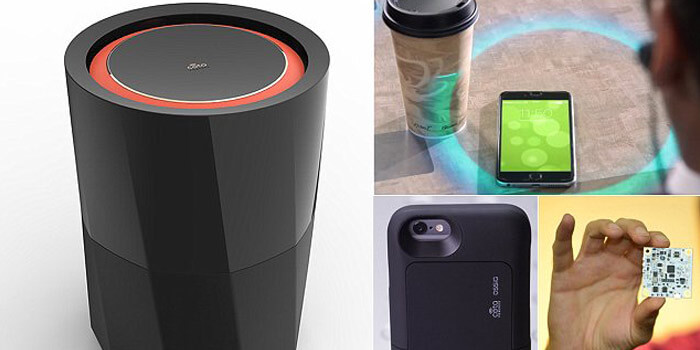A ‘wireless charger’ is an expression that has been wrongly used quite a lot of times in the past for devices mistaken to do the aforementioned, but Ossia, the company behind the breakthrough wireless technology, has developed a system to actually charge your phone without a wire connected to it. You may have previously seen underwhelming wireless technology that either had to be making contact with some sort of power source or be extremely close to a charging panel, but at Consumer Electronics Show (CES) 2016, Ossia demonstrated their wireless technology which left the audience amazed.
Ossia’s wireless charging system, though confusing to understand, is exceptionally brilliant. This system uses the Cota transmitter technology in devices that need to be upgraded with an in-built RF chip. The Cota chip allows radio waves to be sent to and from the device, and converted into energy and stored in the battery. This chip does not necessarily have to be built into devices for them to charge wirelessly, but it definitely is a more sophisticated solution. Without this chip, any smartphone would have to be protected by a huge cover. Though already small in size, Ossia is trying to further reduce the chip so that it can be squeezed into the hardware of smartphones and tablets. Nevertheless, older smartphone devices only need a case to upgrade and use this wireless technology.

When displayed at CES 2016, the wireless charger, at a glance, looks similar to a shoebox, but works perfectly by sending power signals and charging an iPhone in midair. Naturally, the iPhone had to be covered in a special case as, according to the iPhone sizes, the device itself does not allow for wireless charging, but the concept shows that you could soon be charging your devices automatically through the Cota wireless charging technology.
Unsatisfactory battery life in the design of remarkable electronic devices is the primary concern for many technology experts, but Ossia’s Cota might just be their best option to consider those devices. With batteries getting smaller and smaller in size, the on-screen time automatically reduces for most mobile phones, Ossia’s wireless technology, however, aims to remedy this situation. Even though you are still limited to how much battery your mobile phone can hold, at least now, you don’t have to worry about your mobile phone running out of battery. Mid-day phone charging can also be eliminated from your routine!
Almost all of us are fed up with tangling wire messes that are created by the conventional charging wires and the overly sensitive charging pins. Much like a router sending Wi-Fi signals across a room, the Cota transmitter sends power wirelessly around a room, putting an end to our messy wire problem. Cota uses phased antennas to deliver power without the use of inductive coils, ultrasonic waves, magnetic resonance, charging pads or mats to devices about 30 feet away. Even so charging is currently four times slower than using a cable, but this might not be a problem if the Cota transmitter is placed in a room where an individual spends most of their time, for example.
Currently, only one device can receive power at one time, meaning that the Cota transmitter may not be convenient in a small office environment where a number of people have mobile phones. However, the hub range of the Cota transmitter is expected to be increased to cover a whole house or office. IPhone app development in Los Angeles by veztekUSA also reported that an app will be made available that will be able to prioritize devices in the order of the most charging needs, which means that the app will be able to recognize the devices that require charging first.
Ossia also revealed that the Cota technology is inherently safe as signals cannot travel through a person or other obstacles. Tracking beacons have a low power signal which is around 1/10,000th the signal power of Wi-Fi. The physical properties of wireless signals are what help Cota power signals naturally avoid anything that absorbs energy, such as people, pets and even plants.
Ossia’s Cota is capable of charging virtually any consumer device that uses wireless power, including smartphones, remote controls, digital cameras, electric toothbrushes, smoke detectors, and a range of connected home devices, such as thermostats, and much more. Ossia plans to release this gadget by the end of the year, which means that you will be able to wirelessly charge your phone from 2016! Prices for the device are yet to be announced. After its release, Ossia’s Cota will mark the start of a new technological era and will revolutionize the way you charge your electronic devices.

























Find Us on Social Media
A MarTech - Marketing and Technology Blog